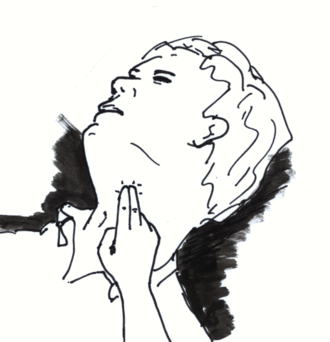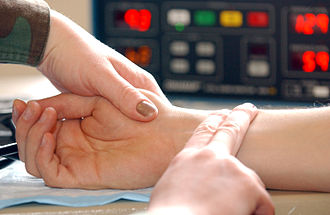AY Honors/Heart and Circulation/Answer Key/es
| Corazón y circulación | ||
|---|---|---|
| Asociación General
|
Destreza: 1 Año de introducción: 2006 |
|
Requisitos
1
Corazón
El corazón es un órgano muscular responsable de bombear la sangre a través de los vasos sanguíneos.
Los vasos sanguíneos
Los vasos sanguíneos son como tubos dentro del cuerpo a través del cual fluye la sangre. Funcionan para transportar a la sangre por todo el cuerpo.
La sangre
La sangre es un fluido especializado que consta de glóbulos rojos, glóbulos blancos y plaquetas suspendidas en un medio fluido complejo conocido como el plasma sanguíneo. El plasma sanguíneo es el componente líquido de la sangre, en el que están suspendidas las células de la sangre. Es un poco más de la mitad del volumen total de la sangre. Las células más abundantes en la sangre son los glóbulos rojos. Los glóbulos rojos transportan oxígeno a todas las otras células en el cuerpo y llevan el dióxido de carbono (y otros desechos) lejos de ellos. Los glóbulos blancos ayudan a resistir las infecciones y las plaquetas son importantes en la coagulación de la sangre.
Los pulmones
La función principal de los pulmones es el transporte de oxígeno de la atmósfera en el torrente sanguíneo y para deshacerse del dióxido de carbono de la sangre a la atmósfera.
2
Las arterias son vasos sanguíneos musculares que transportan la sangre desde el corazón. Todas las arterias, con la excepción de las pulmonares y las arterias umbilicales, llevan la sangre oxigenada.
Veins are blood vessels that carry blood toward the heart. The majority of veins in the body carry low-oxygen blood from the tissues back to the heart; the exceptions being the pulmonary and umbilical veins which both carry oxygenated blood.
Capillaries are the smallest of a body's blood vessels, measuring 5-10 μm, and are important for the interchange of oxygen, carbon dioxide, and other substances between blood and tissue cells. The walls of capillaries are composed of only a single layer of cells, the endothelium. This layer is so thin that molecules such as oxygen, water and lipids can pass through them by diffusion and enter the tissues. Waste products such as carbon dioxide and urea can diffuse back into the blood to be carried away for removal from the body. Capillaries are so small the blood cells need to pass through it in a single file line. Capillaries carry blood from the arteries to the veins.
3
A person's pulse is the throbbing of their arteries as an effect of the heart beat. It can be felt at the neck (carotid artery), at the wrist (radial artery), behind the knee (popliteal artery), on the inside of the elbow (brachial artery), near the ankle joint (posterior tibial artery), and a few other places.
The easiest places to detect the pulse are at the neck and wrist. To detect it at the neck, place the index and middle fingers side-by-side lightly on the neck just below the corner of the jawbone. Do not press too hard as this can alter the pulse, and in some cases cause the person to pass out.
To detect it at the wrist, again place the fingers side-by-side on the smooth side of the wrist a few centimeters![]() below the thumb. Do not use the thumb to take the pulse, as the pulse can be detected in the thumb itself which can interfere with the pulse one is attempting to measure.
below the thumb. Do not use the thumb to take the pulse, as the pulse can be detected in the thumb itself which can interfere with the pulse one is attempting to measure.
Once you can feel the pulse at either location, count the number of throbs over a 15 second period and multiply that by 4 to get the number of beats per minute.
4
The exercise should affect your heart rate in two distinct ways. The first is pretty obvious, in that the heart rate should go way up during and just after the exercise. The second effect is more subtle, and this is the reason the exercise should be repeated daily for a week (though 20 minute sessions will be far more effective than 5 minute sessions). After a week of exercise, the heart rate should be lower when at rest. Furthermore, it should recover to the resting rate more quickly.
This would be a good time to look at the Physical Fitness honor, as it requires aerobic exercise (which raises the heart rate for 20 minutes or longer) over a period of three months. After three months of engaging in aerobic exercise at least four times per week, there should be a noticeable improvement in the heart rate, and an improvement in general health to boot.
5
A simple stethoscope can be made by connecting the small end of a funnel to a length of tubing. Instead of a funnel, you can use the top of a plastic soda or water bottle. If you cut the top off a bottle for use as a funnel, it would be a good idea to line the cut edge with a bit of tape folded over so that there are no sharp edges.
Place the funnel over the "patient's" heart and put the other end of the tubing up to the ear (but not in the ear!). You should be able to hear the heartbeat.
For a more sophisticated stethoscope that works better, use a medicine cup and a balloon instead of a funnel as shown in this video:
6
- Get regular exercise
- Eat a healthy well-balanced diet, avoiding trans-fats, hydrogenated oils, and cholesterol.
- Do not smoke (and avoid second-hand smoke as well)
- Don't abuse drugs or alcohol
- Reduce stress and anxiety
7
Cholesterol is a substance found in the cell membranes of all tissues, and it is transported in the blood plasma of all animals. It is required for normal cellular function. Cholesterol is either made by the body, or derived from the diet, in which case it is delivered by the bloodstream.
If the diet contains too much cholesterol, it will cause a condition known as arteriosclerosis. Arteriosclerosis is a general term describing any hardening (and loss of elasticity) of medium or large arteries. This is caused when excess cholesterol is deposited on the inside of the arteries in the form of plaque. As the plaque builds up, the inside of the artery becomes smaller and smaller, and that makes the heart have to work harder and harder to get the blood through.
Sometimes these plaque build-ups inside the arteries can break loose. Remember that arteries carry blood away from the heart, and they get smaller and smaller until they reach the capillaries which are very tiny indeed. A loose chunk of plaque in the bloodstream will therefore find itself lodged in a small artery that it cannot get through, blocking all blood flow to that part of the body.
8
A heart attack is a medical condition that occurs when the blood supply to a part of the heart is interrupted, most commonly due to rupture of a plaque deposit as described in the previous requirement. When the heart tissue cannot get oxygen, it dies. If enough of the heart tissue dies, the heart will stop beating, and unless something is done, the person will die.
CPR is that "something" that can be done to keep a person from dying if the heart stops beating. The first component of CPR involves repeatedly compressing the chest. This causes the heart to compress as well, squeezing the blood out of it and into the arteries. The compression is then released and the heart draws more blood from the veins. It is, in effect, a way of making a person's heart pump blood. The second component of CPR is for the rescuer to blow air into the victim's mouth or nose to add oxygen to the lungs (and hence, into the blood).
If CPR can be performed until a defibrillator can deliver an electric shock to the heart to restart it, the chances of survival are greatly increased.
See the CPR honor for details on how to become certified to administer CPR.
9
An electrocardiogram (ECG or EKG, abbreviated from the German Elektrokardiogramm) is a graphical representation of electrical activity of the heart over time.
Analysis of the various waves yields important information to a doctor:
- It is the gold standard for the diagnosis of cardiac arrhythmias.
- It guides therapy and helps determine risk for patients who may have had a heart attack.
- It helps detect electrolyte disturbances.
- It allows for the detection of abnormalities.
- It is used as a screening tool for heart disease during a cardiac stress test
- It is occasionally helpful with non-cardiac diseases such as hypothermia.
10
The word heart occurs hundreds of times in the Bible. These texts are all from the New International Version, and were selected because they can be applied to your heart.
Psalm 51:10
- Create in me a pure heart, O God,
- and renew a steadfast spirit within me.
Deuteronomy 6:5
- Love the LORD your God with all your heart and with all your soul and with all your strength.
1 Chronicles 16:10
- Glory in his holy name;
- let the hearts of those who seek the LORD rejoice.
Psalm 7:10
- My shield is God Most High,
- who saves the upright in heart.
Psalm 38:10
- My heart pounds, my strength fails me;
- even the light has gone from my eyes.
Job 37:1
- At this my heart pounds
- and leaps from its place.
Referencias
- Pages with broken file links
- Categoría: Tiene imagen de insignia
- Adventist Youth Honors Answer Book/Honors/es
- Adventist Youth Honors Answer Book/es
- Adventist Youth Honors Answer Book/Skill Level 1/es
- Categoría: Libro de respuestas de especialidades JA/Especialidades introducidas en 2006
- Adventist Youth Honors Answer Book/General Conference/es
- Adventist Youth Honors Answer Book/Health and Science/es
- Adventist Youth Honors Answer Book/Health and Science/Primary/es
- Adventist Youth Honors Answer Book/Stage 100/es



